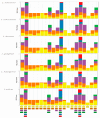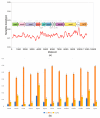Mitochondrial Genomes of Six Snakes (Lycodon) and Implications for Their Phylogeny
- PMID: 40428315
- PMCID: PMC12110799
- DOI: 10.3390/genes16050493
Mitochondrial Genomes of Six Snakes (Lycodon) and Implications for Their Phylogeny
Abstract
Background: Colubridae, known to be one of the most species-rich snake families, remains relatively understudied in termshe context of complete mitochondrial genome research. This study provide the first systematic characterization of the mitochondrial genomes of six colubrid species: Lycodon subcinctus, Lycodon rosozonatus, Lycodon fasciatus, Lycodon gongshan, Lycodon futsingensis, and Lycodon aulicus.
Method: In this study, mitochondrial genomes were sequenced using Sanger sequencing. The raw data were subjected to quality- filtered withing using Fastp and subsequently assembled into complete mitochondrial genomes via SPAdes. Gene annotation was performed by Tblastn, Genewise (for CDS coding sequences), MiTFi (for transfer RNAs), and Rfam (for ribosomal RNAs). Sequence analyses were conducted with various tools, including MEGA, tRNAscan-SE, DnaSP, MISA, and REPuter. Finally, phylogenetic trees were reconstructed based on 13 protein-coding genes from 14 species.
Results: The mitogenomes of these six species ranged from 17,143 to 17,298 bp in length and con-sisted of 13 protein-coding genes (PCGs), 22 transfer RNA genes (tRNAs), 2 ribosomal RNA genes (rRNAs), and 2 control regions. The nucleotide composition of the Colu-bridae mitogenomes was comparable with an A + T composition ranging from 52.1% to 58.8% except for the trnS1 and trnC. All the tRNAs could fold into a stable secondary structure. The Pi and Ka/Ks values suggested that atp8 was the fastest-evolving gene, while cox1 was the most conserved gene. Bayesian inference and maximum likelihood phylogenetic analyses yielded consistent results, with the six sequenced species clus-tering together with their congeneric species. These findings will provide valuable references for further research on the phylogeny of Colubridae.
Keywords: Lycodon; comparative analysis; mitochondrial genome; phylogenetic relationships.
Conflict of interest statement
The authors declare no conflicts of interest.
Figures




Similar articles
-
The complete mitochondrial genome of the Amur rat-snake Elaphe schrenckii (Squamata: Colubridae).Mitochondrial DNA A DNA Mapp Seq Anal. 2016 Jul;27(4):2529-30. doi: 10.3109/19401736.2015.1038789. Epub 2015 May 28. Mitochondrial DNA A DNA Mapp Seq Anal. 2016. PMID: 26017041
-
Sequencing and analysis of the complete mitochondrial genome of Elaphe anomala (Squamata Colubridae).Mitochondrial DNA A DNA Mapp Seq Anal. 2016 Jul;27(4):2742-3. doi: 10.3109/19401736.2015.1046174. Epub 2015 Jun 9. Mitochondrial DNA A DNA Mapp Seq Anal. 2016. PMID: 26057014
-
Complete mitochondrial genome of Lycodon flavozonatum and implications for Colubridae taxonomy.Mitochondrial DNA A DNA Mapp Seq Anal. 2016 Sep;27(5):3473-4. doi: 10.3109/19401736.2015.1066354. Epub 2015 Jul 21. Mitochondrial DNA A DNA Mapp Seq Anal. 2016. PMID: 26195217
-
Comparative mitogenomic analysis of the superfamily Pentatomoidea (Insecta: Hemiptera: Heteroptera) and phylogenetic implications.BMC Genomics. 2015 Jun 16;16(1):460. doi: 10.1186/s12864-015-1679-x. BMC Genomics. 2015. PMID: 26076960 Free PMC article.
-
Complete mitochondrial genomes of Thyreophagus entomophagus and Acarus siro (Sarcoptiformes: Astigmatina) provide insight into mitogenome features, evolution, and phylogeny among Acaroidea mites.Exp Appl Acarol. 2022 Sep;88(1):57-74. doi: 10.1007/s10493-022-00745-4. Epub 2022 Oct 18. Exp Appl Acarol. 2022. PMID: 36255591 Review.
References
-
- Pyron R.A., Burbrink F.T., Colli G.R., De Oca A.N.M., Vitt L.J., Kuczynski C.A., Wiens J.J. The phylogeny of advanced snakes (Colubroidea), with discovery of a new subfamily and comparison of support methods for likelihood trees. Mol. Phylogenetics Evol. 2011;58:329–342. doi: 10.1016/j.ympev.2010.11.006. - DOI - PubMed
-
- Lanza B. A new specics of Lycodon from the Philippines, with a key to the genus (Reptilia Serpentes Colubridae) Trop. Zool. 1999;12:89–104. doi: 10.1080/03946975.1999.10539380. - DOI
-
- Che J., Jiang K., Yan F., Zhang Y. Amphibians and Reptiles in Tibet—Diversity and Evolution. Science Press; Beijing, China: 2020.
-
- Guo P., Che J. Snakes in Qinghai-Xizang Plateau. Science Press; Beijing, China: 2024. p. 229.
MeSH terms
Substances
Grants and funding
LinkOut - more resources
Full Text Sources
Research Materials
Miscellaneous

